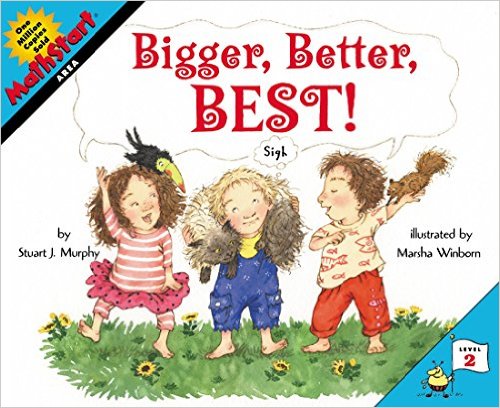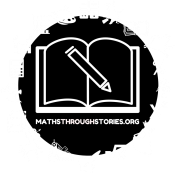BIGGER, BETTER, BEST!
Author: Stuart J. Murphy
Illustrator: Marsha Winborn
|
Number of pages: 31
Publisher: HarperCollins (USA) First published in: 2002 Format: Picturebook Is the mathematical focus explicit in the story? Yes Is this story part of a mathematics story series? Yes (MathStart) Preview and/or purchase this book on the Amazon websites: UK, USA, AUS, IND, CAN Synopsis by the author/publisher
In their family′s new house, Jenny and Jeff are driving their little sister, Jill, crazy. Who has the bigger window? Who has the bigger bedroom? Jenny and Jeff must use a simple geometry concept to calculate area in order to prove once and for all whose room is bigger. |
“Jill helped Jeff tape sheets of paper up one side of his window. "It's 3 sheets high," Jeff announced. Then he made as many row as he could across the window. "I can make 4 rows," he said. "That's 12 sheets of paper in all."”
Official review by MathsThroughStories.org:
Stuart J. Murphy’s ‘Bigger, Better, Best’ (2002) is a story about three young siblings, Jeff, Jenny and Jill. Jeff and Jenny always fight on who has bigger and better things. When they move to their new home, the fight starts again. This time on whose room has a larger window. With the help of their mum, Jeff and Jenny use sheets of paper to measure the size of their windows by working out whose window requires more sheets of paper to cover the window entirely. Jeff’s window is three sheets of paper wide and four sheets of paper long, while Jenny’s window is two sheets of paper wide and six sheets of paper long. Not satisfied that their windows are essentially the same size, they find something else to fight over with. This time, who has a bigger room. With the help of their father, Jeff and Jenny realise that instead of using sheets of paper to measure their room’s floorspace, it would be easier and quicker if they use a bigger unit of measurement like sheets of newspaper. Again, despite the different dimensions, their rooms are roughly the same. Jill, as it turns out, has the smallest room and window, but she does not mind as her room is the farthest away from Jeff’s and Jenny’s and all their constant fighting! In terms of mathematics teaching, this story is quite versatile: not only could you use this story to introduce the concept of surface area of rectangular shapes, the story is also perfect to teach multiplication, specifically in terms of arrays. We can see a wide range of fun and practical learning activities that teachers and parents can do with their children after finish reading the story, for example, they can get children to actually measure the surface area of their desks with sheets of paper and to measure the floorspace of their classroom or gym with sheets of newspaper and other bigger non-standard measurement units. All in all, we highly recommend ‘Bigger, Better, Best’ to introduce the concept of finding surface area of rectangular shapes, and multiplication arrays to children, aged 7+ years old.
Recommended age range:
7+ years old
Relevant mathematics topics:
Area & Perimeter; Multiplication
Possible teaching activities:
At MathsThroughStories.org, we believe that stories can be meaningfully incorporated in mathematics teaching in different ways. Thus, we are inviting you to share your experience of how you have used this story in your mathematics lesson with other members of the community. By sharing your experience with us, you will be added to our team of On-line Contributors here, where you can also find our submission guideline.
Stuart J. Murphy’s ‘Bigger, Better, Best’ (2002) is a story about three young siblings, Jeff, Jenny and Jill. Jeff and Jenny always fight on who has bigger and better things. When they move to their new home, the fight starts again. This time on whose room has a larger window. With the help of their mum, Jeff and Jenny use sheets of paper to measure the size of their windows by working out whose window requires more sheets of paper to cover the window entirely. Jeff’s window is three sheets of paper wide and four sheets of paper long, while Jenny’s window is two sheets of paper wide and six sheets of paper long. Not satisfied that their windows are essentially the same size, they find something else to fight over with. This time, who has a bigger room. With the help of their father, Jeff and Jenny realise that instead of using sheets of paper to measure their room’s floorspace, it would be easier and quicker if they use a bigger unit of measurement like sheets of newspaper. Again, despite the different dimensions, their rooms are roughly the same. Jill, as it turns out, has the smallest room and window, but she does not mind as her room is the farthest away from Jeff’s and Jenny’s and all their constant fighting! In terms of mathematics teaching, this story is quite versatile: not only could you use this story to introduce the concept of surface area of rectangular shapes, the story is also perfect to teach multiplication, specifically in terms of arrays. We can see a wide range of fun and practical learning activities that teachers and parents can do with their children after finish reading the story, for example, they can get children to actually measure the surface area of their desks with sheets of paper and to measure the floorspace of their classroom or gym with sheets of newspaper and other bigger non-standard measurement units. All in all, we highly recommend ‘Bigger, Better, Best’ to introduce the concept of finding surface area of rectangular shapes, and multiplication arrays to children, aged 7+ years old.
Recommended age range:
7+ years old
Relevant mathematics topics:
Area & Perimeter; Multiplication
Possible teaching activities:
At MathsThroughStories.org, we believe that stories can be meaningfully incorporated in mathematics teaching in different ways. Thus, we are inviting you to share your experience of how you have used this story in your mathematics lesson with other members of the community. By sharing your experience with us, you will be added to our team of On-line Contributors here, where you can also find our submission guideline.

